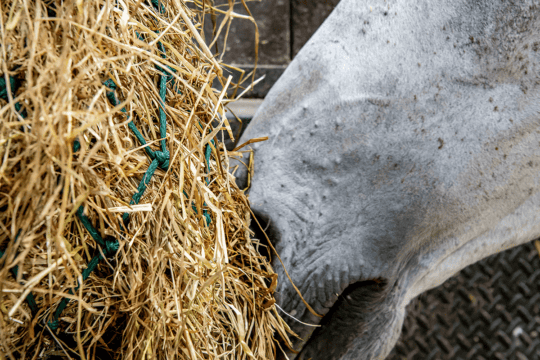It strikes fear into the hearts of horse owners, but does arthritis have to be career-ending and what options do you have if your horse is diagnosed?
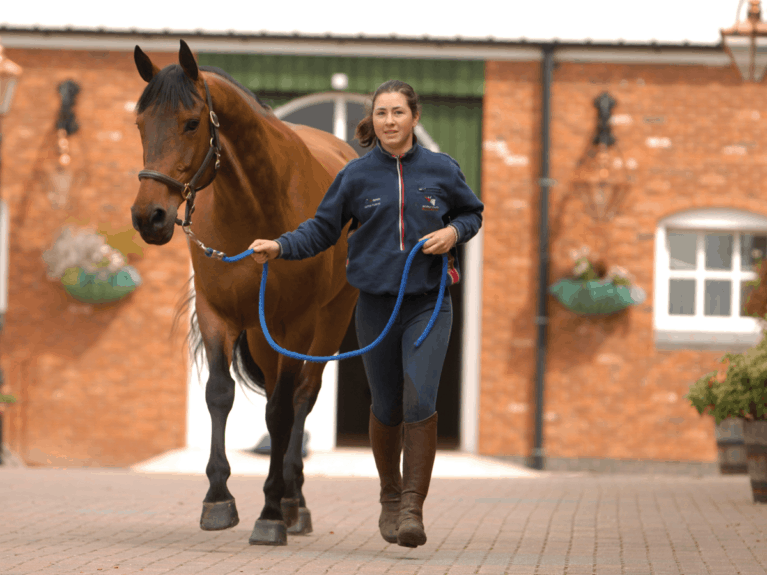
When you think of arthritis, what comes to mind? The chances are that you’re not thinking of athletes at the height of their abilities. But an arthritis diagnosis isn’t quite so black and white, and with careful management, your horse may well be able to do more than you think.
In simple terms, arthritis affects the function of a joint and causes painful or stiff movement. The disease goes through various stages and, depending on how early it’s caught and how it’s treated, can have little effect on your horse’s capacity for work or, in severe cases, be career-ending. In most cases, however, it’s possible to continue to enjoy your horse while offering him a great quality of life, it just requires some adjustments to his daily routine.
It’s vital to understand that the effect that arthritis has on your horse’s body isn’t just limited to that joint. As he compensates for soreness, stiffness or limitations to his movement, discomfort can extend around his body, resulting in stiffness or inflexibility under saddle and often sending you on a wild goose chase trying to pinpoint the cause of the changes.
Signs to spot
If you suspect your horse has arthritis, it’s important to get your vet out as soon as possible, because although there’s no cure for the disease, it’s easier to manage its symptoms the earlier it’s caught.
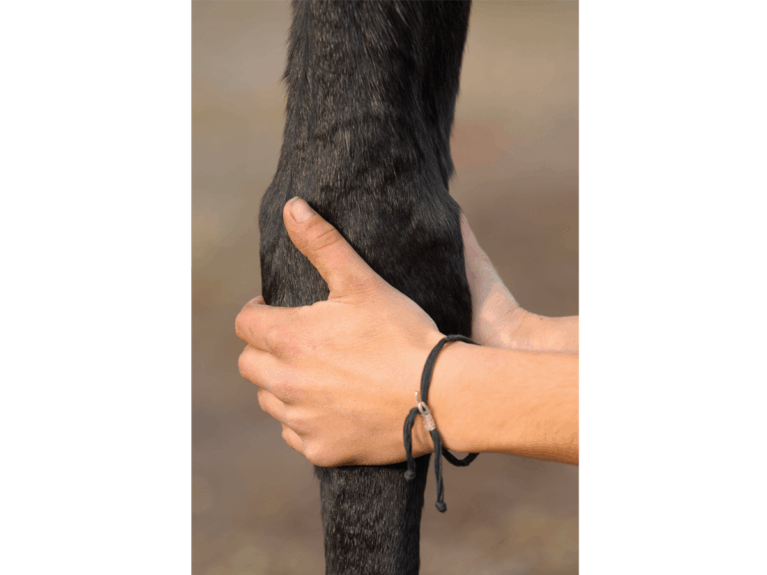
Some common indicators of arthritic changes include…
- stiffness
- reduced lateral flexibility
- unwillingness to move forward
- uncharacteristic refusals while jumping
- heat and swelling around a joint
- lameness
The right weight
It’s important to prioritise maintaining your horse’s ideal bodyweight in order to prevent adverse effects to his joints. If he’s carrying extra weight, his joints will be forced to work harder to support him, which has a cumulative effect on their long-term flexibility and function. Speak to a vet or an equine nutritionist to calculate your horse’s ideal weight, then regularly check it using a weightape to ensure that it hasn’t crept over the ideal number.
Supplementary feeding
There’s a huge variety of joint supplements on the market designed to support healthy joint function as part of a long-term maintenance regime. Look for active ingredients like glucosamine, which is the most basic building block of cartilage, hyaluronic acid – an oral anti-inflammatory – and chondroitin, which can help to prevent cartilage breakdown. Other ingredients to keep an eye out for include omega-3 fatty acids and vitamin C, although the latter can have adverse side effects and, as such, should only be fed in small doses.
TOP TIP
Both omega-3 and omega-6 fatty acids are essential components of a balanced diet, but when feeding your horse, it’s important to ensure that the omega-3 content of his feed is higher than the omega-6. This is because omega-6 fatty acids promote inflammation, which is necessary for the healing of injuries, but should be minimised in arthritic joints.
Riding it out
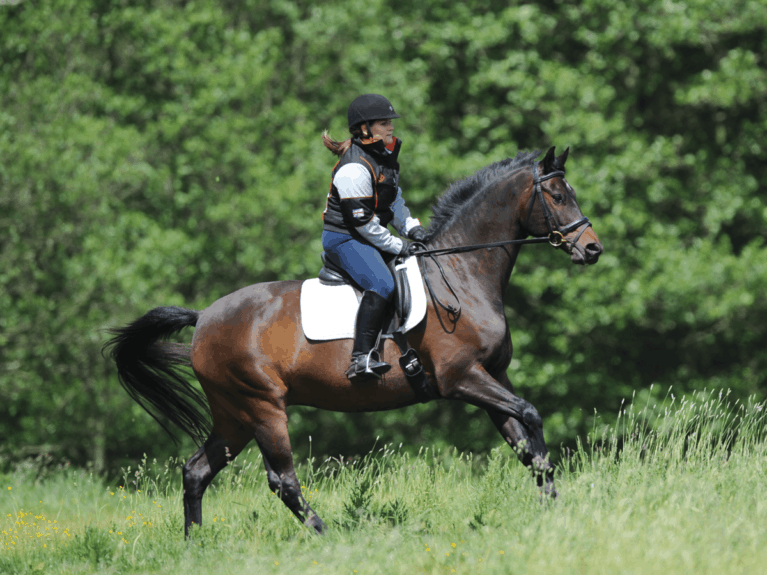
Maintaining an exercise routine is key to keeping your horse comfortable, as regular movement encourages the production of synovial fluid, and helps to strengthen the muscles and ligaments that support the joint. However, you may find that you need to make some adjustments to your expectations in order to keep him sound…
- allow for a longer warm-up and focus on stretching exercises – for example, stretchy trot circles – to help counteract his stiffness.
- tailor your schooling sessions to his needs – for example, working on smaller circles and doing a lot of jumping puts more strain on your horse’s joints than gentle flatwork, so don’t overdo it and pay attention to how he feels after a workout.
- work in tandem with your vet to create an exercise plan that helps, rather than hinders, the specific limitations of your horse’s arthritic condition.
- be conscious of the surfaces that you ride your horse on – too much work on excessively hard ground, uneven surfaces or slippery going can cause extra wear and tear on his joints, speeding up the progression of the disease. Pay attention to how your horse reacts to certain conditions and surfaces, then structure his routine around his needs. He may find a harder surface more supportive or he may end up sore after doing roadwork. Likewise, some horses will find that the harder work required to work on a soft surface exacerbates the problem while, for others, the cushioning effect may be more comfortable. Avoid rutted fields, as picking his way across them increases the twist and torque on his joints.
- be flexible, because your horse is likely to have the occasional day when he doesn’t feel his best, so don’t get hung up on getting another schooling session in on those days. Instead, take him for a gentle hack. One bad day doesn’t mean that his working days are behind him, but pushing him to work through them could shorten his career.
TOP TIP
Short, regular exercise sessions tend to be more beneficial than sporadic, longer sessions. Unmounted exercise is great for your horse as well, so if you’re unable to ride every day, why not try long-reining or walking him in-hand?
The comfort factor
If you suffer from a bad back or joint pain, you know how it feels to wake up in a different bed and feel crippled by stiffness. An arthritic horse will feel the same if kept in an insufficiently bedded stable. If your horse is stabled on a concrete floor, consider installing rubber matting, as even deep beds can shift beneath a sleeping horse, removing its cushioning effects on his joints.
Cold, damp weather can cause compromised joints to stiffen up, so ensure that your horse is correctly rugged in these conditions. Consider using an exercise rug to contain the heat over his quarters when the temperature drops, and avoid leaving him completely unrugged during grooming sessions on colder days. While fresh air is vital, limiting draughts is important while his movement is restricted by a stable. He may benefit from bandages or leg wraps on cold nights, too.
Tactical turnout
Regular turnout helps to keep your horse moving, which is key to maintaining joint function. To maximise the benefits, keep a few things in mind…
- choose his companions wisely. A field full of rambunctious youngsters or alpha types looking to establish a pecking order won’t do your horse any favours. Turn him out with another quiet companion instead. If group turnout is unavoidable, try to keep him with a calm group of horses and ensure that any hay that’s fed in the field is sufficiently spaced out with two more piles than there are horses – this will prevent
him from getting caught up in an argument about food - make sure he’s dressed appropriately. Keep his wardrobe well-stocked with lightweight rugs as well as heavier ones for chillier days. If he’s sensitive to flies, make sure he’s sufficiently protected against them – a horse who is fed up of being bitten is more likely to start galloping around his field or stamp his feet, neither of which will benefit arthritic joints
- check the ground. A flat, level field without rutted ground or holes is best, as this minimises the impact on your horse’s joints and reduces the risk of a field injury

TOP TIP
Pay attention to your horse’s needs on a day-by-day basis, and be prepared to adjust your plan and give your horse a day off in the field if he’s having a sore day.
Keep a record
A daily diary can help you to identify patterns in your horse’s routine and the way that he responds to them, helping you to modify the way you manage him and predict when he’ll be more stiff. Every day, note the weather, including the minimum and maximum temperature, describe his exercise that day and write down how long he was turned out for. If he’s on a course of medication, make sure you write down which days the drug is administered. Then, give him a stiffness score from 1–5, with 1 being the least stiff and 5 being the most stiff. Over time, you’ll be able to spot when the problem is exacerbated – for example, if he tends to stiffen up after two days off work or if he’s less sore if he gets a couple of extra hours in the field.
A vet’s perspective
Arthritic changes can, in many cases, be successfully managed with the help of medications administered by your vet. Ollie Pynn BVSc CertEP MRCVS of Rossdales in Newmarket demystifies the options…
non-steroidal anti-inflammatory drugs (NSAIDs)
Your vet can prescribe your horse a course of NSAIDs, such as phenylbutazone (bute) or metacam, either to minimise symptoms over a short-term period, which can be useful when diagnosing the nature and extent of the condition, or as part of a long-term maintenance programme.
NSAIDs are a non-invasive method of minimising pain and inflammation, and are easy to administer – once your vet has prescribed them to your horse, all you’ll need to do is add the drug to his feed for the specified amount of time. Remember that for your horse to be prescribed bute he must be signed ‘not for human consumption’ in his passport.
Long-term use can lead to unwanted side effects such as gastric ulceration or kidney damage, but these are rare. Your horse will also not be allowed to compete while on NSAIDs.
systemic joint medication
There are medications that can be injected into your horse either by intra-muscular injection – for example, cartrophen – or by intravenous injection – for example, hyaluronic acid. They have anti-inflammatory properties but also improve the production of synovial fluid and support healthy cartilage.
Anti-inflammatory intra-muscular medication, such as cartrophen, is usually injected into the muscle of the quarters, chest or, sometimes, neck. It works to improve the production of synovial fluid and support healthy cartilage.
Because the injection is into muscle, it will benefit all your horse’s joints. Intra-muscular injections can be administered by you or your yard owner, if you’re experienced at giving them, reducing the cost because you don’t always need a vet to attend if the treatment is part of a routine programme of care.
They need to be administered more often than intra-articular injections. A course of cartrophen consists of four injections, five to seven days apart. After the initial course, your horse may need a booster injection as regularly as once a month.
intra-articular joint medication
Injections directly into the joint can be pricey, and may need to be readministered periodically depending on the severity of the condition, response to treatment and your horse’s workload. However, the positive effect that they can have may well make it worth the cost if you’re hoping to continue your horse’s career.
Joint injections can prolong your horse’s working life and reduce inflammation in the joint. They’re often used as part of a broader management programme.
Whenever a foreign body (in this case, a needle) is introduced into a joint there is always some risk of infection, although your vet will take every precaution to avoid contamination. A small amount of antibiotic in combination with the joint medication will often be used routinely to help avoid this complication.
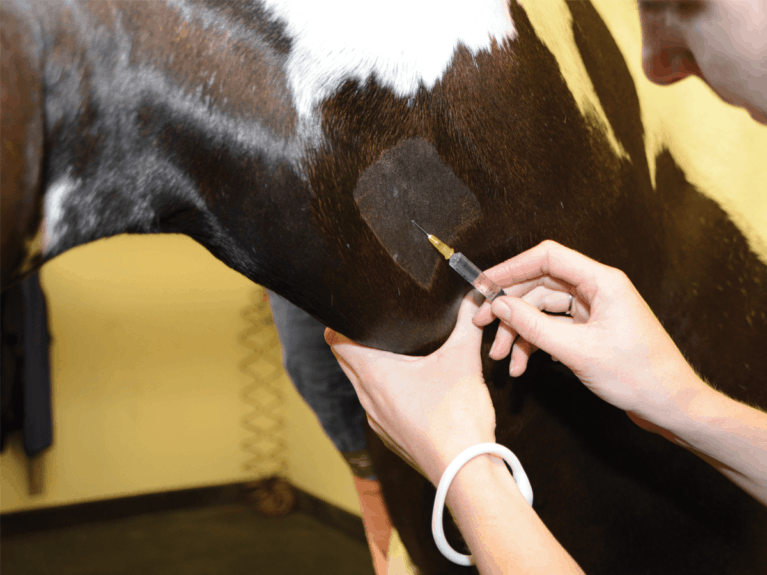
The most common types of joint injection are…
- corticosteroids, which are synthetic anti-inflammatory steroids and the most commonly used joint medication for osteoarthritis. There are a number of steroids that can be used, depending on the extent of the arthritis, which joint is affected and whether the horse is competing, because they have varying withdrawal periods. They’re often injected in combination with hyaluronic acid.
- hyaluronic acid, which is a naturally occurring substance that’s produced in the membrane of the joint. When reinjected, it helps to lubricate the joint.
- IRAP (interleukin-1 receptor antagonist protein), which is a newer type of joint medication. It counteracts the inflammatory protein interleukin-1, which is produced in the joint when the joint becomes inflamed. A blood sample is taken from your horse, which is then processed in the laboratory to produce IRAP. This is then reinjected into his joints.
- platelet rich plasma, which is also derived from your horse’s own blood. It’s more commonly used for soft tissue injuries, although it can be injected into your horse’s joints. It contains a high concentration of growth factors, which are aimed at promoting healing with the joint.
- polyacrylamide hydrogel, which is a new joint therapy that, when injected into your horse’s joint, works to provide a cushioning effect.
TOP TIP
There is no cure for arthritis and injections won’t rebuild a damaged joint, but they can help to maintain functional levels of movement and minimise discomfort.






